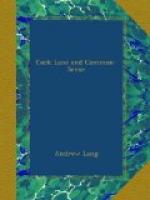The savage with the long name was a Christian catechumen, and yet he stood to it that he had seen a sorcerer disappear before his very eyes, like the second-sighted Highlander in Kirk’s Secret Commonwealth (1691). ’His neibours often perceaved this man to disappear at a certane place, and about one hour after to become visible.’ It would be more satisfactory if the Father had seen these things himself, like Mrs. Newton Crosland, who informs the world that, when with Robert Chambers and other persons of sanity, she felt a whole house violently shaken, trembling, and thrilling in the presence of a medium—not a professional, but a young lady amateur. Here, of course, we greatly desire the evidence of Robert Chambers. Spirits came to Swedenborg with a wind, but it was only strong enough to flutter papers; ‘the cause of which,’ as he remarks with naivete, ‘I do not yet understand’. If Swedenborg had gone into a Medicine Lodge, no doubt, in that ‘close place,’ the phenomena would have been very much more remarkable. In 1853 Pere Arnaud visited the Nasquapees, and describes a seance. ’The conjurers shut themselves up in a little lodge, and remain for a few minutes in a pensive attitude, cross-legged. Soon the lodge begins to move like a table turning, and replies by bounds and jumps to the questions which are put to the conjurer.’ {48} The experiment might be tried with a modern medium.
Father Lejeune, in 1637, gives a case which reminds us of Home. According to Home, and to Mrs. S. C. Hall, and other witnesses, when ‘in power’ he could not only handle live coals without being burned, but he actually placed a large glowing coal, about the size of a cricket-ball, on the pate of Mr. S. C. Hall, where it shone redly through Mr. Hall’s white locks, but did him no manner of harm. Now Father Pijart was present, tesmoin oculaire, when a Huron medicine-man heated a stone red hot, put it in his mouth, and ran round the cabin with it, without receiving any harm. Father Brebeuf, afterwards a most heroic martyr, sent the stone to Father Lejeune; it bore the marks of the medicine-man’s teeth, though Father Pijart, examining the man, found that lips and tongue had no trace of burn or blister. He reasonably concluded that these things could not be done ‘sans l’operation de quelque Demon’. That an excited patient should not feel fire is, perhaps, admissible, but that it should not scorch either Mr. Hall, or Home, or the Huron, is a large demand on our credulity. Still, the evidence in this case (that of Mr. Crookes and Lord Crawford) is much better than usual.
It would be strange if practices analogous to modern ‘table-turning’ did not exist among savage and barbaric races. Thus Mr. Tylor, in Primitive Culture (ii. 156), quotes a Kutuchtu Lama who mounted a bench, and rode it, as it were, to a tent where the stolen goods were concealed. The bench was believed, by the credulous Mongols, to carry the Lama! Among the Manyanja of Africa thefts are detected




